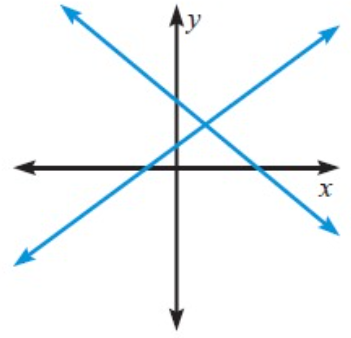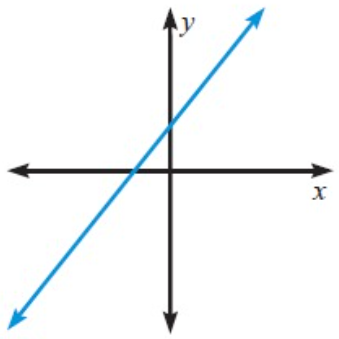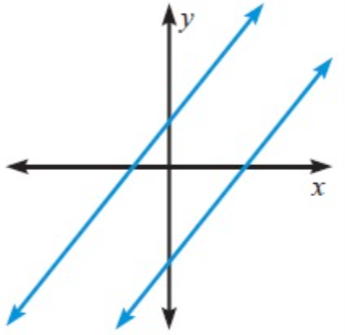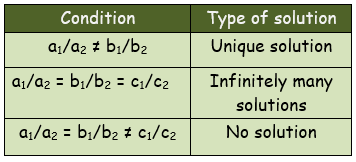NUMBER OF SOLUTIONS OF LINEAR SYSTEM
Subscribe to our ▶️ YouTube channel 🔴 for the latest videos, updates, and tips.
The graph of the system is a pair of lines that intersect in one point.

The graph of the system is a pair of lines that intersect in one point.

The graph of the system is a pair of parallel lines so that there is no point of intersection.

Without solving the equations completely, we can find how many solutions they will have.
The general form of a pair of linear equations is
a1x + b1y + c1 = 0
a2x + b2y + c2 = 0
(where a1, a2, b1, b2, c1, and c2 are real numbers)
If a pair of linear equations is given by
a1x + b1y + c1 = 0
a2x + b2y + c2 = 0
We have to check the condition then follow solutions.

Example 1 :
2x – y = -5
x + 2y = 0
Solution :
By writing the given equations a1x + b1y + c1 = 0 and a2x + b2y + c2 = 0 in the form, we get
2x – y + 5 = 0
x + 2y + 0 = 0
From the equations, let us find the values of a1, a2, b1, b2, c1, and c2
Here a1 = 2, b1 = -1 and c1 = 5
a2 = 1, b2 = 2 and c2 = 0
a1/a2 = 2/1 -----(1)
b1/b2 = -1/2 -----(2)
c1/c2 = 5/0 -----(3)
(1) ≠ (2)
Now, a1/a2 ≠ b1/b2
So, it has unique solution.
Example 2 :
-2x + 3y = 12
2x - 3y = 6
Solution :
-2x + 3y – 12 = 0
2x - 3y – 6 = 0
From the equations, let us find the values of a1, a2, b1, b2, c1, and c2
Here a1 = -2, b1 = 3 and c1 = -12
a2 = 2, b2 = -3 and c2 = -6
a1/a2 = -2/2 = -1 -----(1)
b1/b2 = -3/3 = -1 -----(2)
c1/c2 = 12/6 = 2 -----(3)
(1) = (2) ≠ (3)
Now, a1/a2 = b1/b2 ≠ c1/c2
So, it has no solution.
Example 3 :
2x - y = 5
-4x + 2y = -10
Solution :
2x - y – 5 = 0
-4x + 2y + 10 = 0
Here a1 = 2, b1 = -1 and c1 = -5
a2 = -4, b2 = 2 and c2 = 10
a1/a2 = -2/4 = -1/2 -----(1)
b1/b2 = -1/2 -----(2)
c1/c2 = -5/10 = -1/2 -----(3)
(1) = (2) = (3)
Now, a1/a2 = b1/b2 = c1/c2
So, the given equations are infinitely many solutions.
Example 4 :
x + 5y = -12
x - 5y = 8
Solution :
By writing the given equations a1x + b1y + c1 = 0 and a2x + b2y + c2 = 0 in the form, we get
x + 5y + 12 = 0
x - 5y - 8 = 0
Here a1 = 1, b1 = 5 and c1 = 12
a2 = 1, b2 = -5 and c2 = -8
a1/a2 = 1/1 = 1 -----(1)
b1/b2 = -5/5 = -1 -----(2)
c1/c2 = -12/8 = -3/4 -----(3)
(1) ≠ (2)
Now, a1/a2 ≠ b1/b2
So, it has unique solution.
Example 5 :
-x + 5y = 8
2x - 10y = 7
Solution :
-x + 5y - 8 = 0
2x - 10y - 7 = 0
Here a1 = -1, b1 = 5 and c1 = -8
a2 = 2, b2 = -10 and c2 = -7
a1/a2 = -1/2 -----(1)
b1/b2 = -5/10 = -1/2 -----(2)
c1/c2 = 8/7 -----(3)
(1) = (2) ≠ (3)
Now, a1/a2 = b1/b2 ≠ c1/c2
So, it has no solution.
Example 6 :
4x - 7y = 27
-6x - 9y = -21
Solution :
4x - 7y - 27 = 0
-6x - 9y + 21 = 0
Here a1 = 4, b1 = -7 and c1 = -27
a2 = -6, b2 = -9 and c2 = 21
a1/a2 = -4/6 = -2/3 -----(1)
b1/b2 = -7/9 -----(2)
c1/c2 = -27/21 = -9/7 -----(3)
(1) ≠ (2)
Now, a1/a2 ≠ b1/b2
So, it has unique solution.
Example 7 :
For the linear system 2x + 3y = 12 and 4x + 6y = C, what value(s) of C will give the system
a) an infinite number of solutions?
b) no solution?
Solution :
2x + 3y = 12 and 4x + 6y = C
a1/a2 = 2/4
b1/b2 = 3/6
c1/c2 = 12/C
a) Infinite number of solution :
a1/a2 = b1/b2 = c1/c2
2/4 = 3/6 = 12/C
1/2 = 12/C
C = 12(2)
C = 24
So, the value of C is 24.
b) No solution :
a1/a2 = b1/b2 ≠ c1/c2
3/6 ≠ 12/C
1/2 ≠ 12/C
C ≠ 24
So, the value of C is other than 24.
Example 8 :
Suppose you are given only the following pieces of information about a system of linear equations. Would you be able to predict the number of solutions to the system? Explain.
a) The slopes of the lines are the same.
b) The y-intercepts of the lines are the same.
c) The x-intercepts are the same, and the y-intercepts are the same.
Solution :
a) The slopes of the lines are the same.
If the slopes are equal, then it must be parallel line. Then there must be no solution.
b) The y-intercepts of the lines are the same.
Since the y-intercepts are the same, they may have same slopes or different slopes.
- If slopes and y-intercepts are equal, then it may have infinite number of solutions.
- If slopes are not same then it may have unique solution. The solution is at y-intercept.
c) The x-intercepts are the same, and the y-intercepts are the same.
Since x-intercepts and y-intercepts are the same, then it must be the same line. So, it will have infinite number of solution.
Note :
To find the point of intersections particularly, we can use the following methods.
- Substitution Method
- Elimination Method
- Cross multiplication method
Subscribe to our ▶️ YouTube channel 🔴 for the latest videos, updates, and tips.
Kindly mail your feedback to v4formath@gmail.com
We always appreciate your feedback.
About Us | Contact Us | Privacy Policy
©All rights reserved. onlinemath4all.com

Recent Articles
-
10 Hard SAT Math Questions (Part - 39)
Dec 28, 25 11:20 PM
10 Hard SAT Math Questions (Part - 39) -
10 Hard SAT Math Questions (Part - 41)
Dec 28, 25 06:05 PM
10 Hard SAT Math Questions (Part - 41) -
GMAT Quantitative Reasoning Questions and Answers
Dec 27, 25 09:33 PM
GMAT Quantitative Reasoning Questions and Answers
